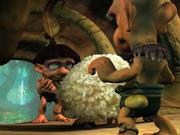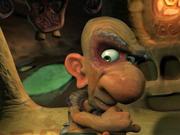Though it isn't prominently announced on the packaging, Tak and the Power of Juju is a game that came to be through collaboration between THQ and Nickelodeon. Though it's angled toward kids, some shortcomings in the design make it no more suitable for the little ones than the average 3D platformer. The game's got a distinctive look to it, and some good moments, but some tedious collection tasks and exploration elements drag the game down.

Tak and the Power of Juju tells the story of the plight of the Pupanunu people. An evil shaman named Tlaloc has stolen the power of the Moon Juju for his own and has turned most of the Pupanunu people into sheep, including their supposed savior, a warrior named Lok. This leaves Tak, a kind of goofy young villager with purple face paint and a Moe Howard haircut, to restore the power of the Moon Juju and save the Pupanunu people. As you might deduce from all the silly-sounding names and the look of the game, Tak and the Power of Juju tries to be funny, with some amusing results.
There are many steps in Tak's journey to save his people, but the actual action is pretty basic platforming business. From the onset, Tak can perform all of the basic platforming moves. He can run, jump, double-jump, hang off of ledges, climb up ropes, slide down ziplines, and whack enemies with his club. Early on you're given a pole which can be used to pole-vault up to higher platforms and can deal greater damage to enemies. It also serves as a blowgun, which is useful for triggering lots of the game's environmental puzzles. Many of these puzzles involve the wildlife that inhabits this world, from rams to rhinos to orangutans. Some of the puzzles can be pretty clever, but rarely are they too difficult to decipher quickly. Aside from these basic puzzles, there are also plenty of items to collect in Tak and the Power of Juju--from feathers to moonstones to gold teeth--and a good majority of your goals will actually revolve around hunting down different trinkets strewn about the game's world. Collecting stuff is a well-worn concept in platformers, and gets old quickly in Tak.
Some behind-the-back snowboarding levels are thrown in to help break up the platforming action, but even these have been done before--and done better--by games like Rayman 3 and Klonoa 2. As can be expected from a 3D platformer, Tak also has some noticeable camera management issues, though, to be fair, it's nothing worse than what you'd find in most any other 3D platformer. But what really hurts Tak the most is its convoluted level designs. The levels are consistently laid out in such a way as to make it painfully unclear exactly where your next objective lies, leaving you to wander the level until you happen upon what you're looking for. This is most frustrating when you've finished all the level goals, and you simply want to return to the main hub level.
The visual style in Tak and the Power of Juju is the most inspired and unique aspect of the game, though this aspect of the game still leaves something to be desired. The environments are kind of blocky, but nice, and watercolored textures offset the lack of polygons, giving the environments a rough-hewn look, as well as providing some extra visual depth. The enemies look fine, from a technical standpoint, but are otherwise sort of generic. Tak himself also looks fine, though some of his most basic animations, like swinging his club, look like they're missing several frames. There are some occasional frame rate issues, but these are mostly incidental, and don't have a profound effect on the actual gameplay experience. The whole game is definitely cribbing a lot of its presentation, and even a little of its attitude, from the Rayman series, which honestly works to Tak's advantage.

Though most of the sound design in Tak and the Power of Juju is pretty pedestrian, it does happen to feature some top-notch voice acting from some industry veterans, with the most noteworthy pipes provided by Patrick Warburton. The quality of the voice acting itself is consistently good, though sometimes the lines they have to read can seem a little forced. The worst of this is shouldered by Tak himself, who will constantly shout out little quips like "Boomshakalaka!" and "Owned!" when he defeats an enemy. These are instantly annoying the first time you hear them, and they only get worse as the game wears on.
Tak and the Power of Juju has some heart, showing off some rather inspired graphics and some decent humor, and it's admittedly a step up from most games aimed specifically at a younger audience. Problem is, the muddled level design causes more frustration than most younger players would probably be willing to tolerate, and the generally commonplace gameplay mechanics limit the game's appeal to more-mature players. Tak and the Power of Juju can serve as a decent platformer, but if you're in the market for one, it shouldn't be your first choice.